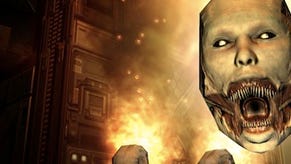DOOM 3 and the Challenge of Living up to Your Own Legacy
How do you top the achievement of changing video games forever? For id Software, the answer was to change directions entirely.
This article first appeared on USgamer, a partner publication of VG247. Some content, such as this article, has been migrated to VG247 for posterity after USgamer's closure - but it has not been edited or further vetted by the VG247 team.
The '90s were defined by big games — Sonic! Street Fighter! Mortal Kombat! Resident Evil! Final Fantasy VII! Gran Turismo! Mario 64! — but id Software's DOOM has a pretty good claim on being the biggest game of the decade.
I remember the first time I ever saw DOOM being played by some friends in the office nook of their dorm room; the gore turned me off, but I couldn't help but be transfixed by the incredible "3D" graphics on display... not to mention envy them, since I'd decided to study graphic design and journalism, and the game wouldn't be available for years on my expensive Mac, the industry-standard tool for people of my chosen field of study. DOOM hit the video game world with megaton impact, the ripples of its arrival changing everything. It was neither the first first-person shooter nor even the most ambitious of its era, but its blazing fast pace, irreverent heavy-metal aesthetics, and engrossing competitive play made it transcendent. The term "first-person shooter" wouldn't come along for several years; until then, everything was just a "DOOM clone."
The problem with changing the world is that once you've done it, everyone keeps an eye on your next accomplishment and expects you to top yourself again and again. It's a tall order for anyone to create a revolutionary work, but even more unlikely to expect them to do it systemically. We see it all the time with Nintendo — seriously, isn't it enough that Shigeru Miyamoto has designed more than half a dozen medium-defining video games? — and it's something id faced when it came time to produce a proper follow-up to DOOM more than a decade later. The FPS had evolved considerably in that time, presenting id with a mighty challenge of their own making: How to top a host of games building off their ideas? Heck, the biggest FPS of the late '90s, Half-Life, ran on id's own Quake engine.
Their solution? Go in a completely different direction. Where the original DOOM was a breakneck shooter, 2004's DOOM 3 felt more like survival horror. Set in stifling corridors shrouded in darkness, DOOM 3 showed off John Carmack's impressive light-casting technology, and the way it forced players to make either-or choices between light or firepower heightened the tension considerably. It was a remarkable piece of work... and a bold attempt to reinvent a classic. But not an entirely successful one, as players chafed at contrivances like cheap, teleporting monster ambushes and the fact that the heroic space marine couldn't figure out how to use light and guns at the same time. You have to admire id for making a go of it, but the fact the DOOM 4 will be going more in the direction of "big, dumb, fast-paced shooter" probably says it all.
Honestly, DOOM 3 reminds me a lot of all those Nintendo Entertainment System sequels that totally threw out the style of their legendary predecessors in favor of trying something new. Like Zelda II. I suppose starting from scratch is a natural instinct for successful game designers who don't want to be pigeonholed... and I suspect giving in and returning to the classic format is the successful designer's natural acceptance of the fact that gamers don't necessarily care for change.
For more of This Day in Video Game History, check out the series hub and subscribe to our YouTube channel!







